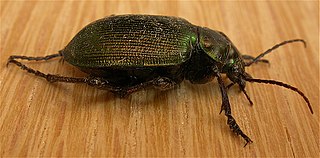
The Calosoma sycophanta or forest caterpillar hunter is a ground beetle belonging to the family Carabidae.

Calosoma is a genus of large ground beetles that occur primarily throughout the Northern Hemisphere, and are referred to as caterpillar hunters or searchers. Many of the 167 species are largely or entirely black, but some have bright metallic coloration. They produce a foul-smelling spray from glands near the tip of the abdomen. They are recognizable due to their large thorax, which is almost the size of their abdomen and much wider than their head.

Calosoma schayeri is a species of Carabidae that occurs in Australia. Like most Carabidae the larvae is predaceous. It is quite active at night when it is found hunting for slow-moving prey such as caterpillars. If handled it gives off an unpleasant scent.

Calosoma auropunctatum, is a species of ground beetle. This species was previously classified as Calosome maderae ssp. auropunctatum. This species is found from Europe eastward to Anatolia, Central Asia and western China and Mongolia.

Calosoma inquisitor is a species of ground beetle. The species is found in northern Africa, Europe and East to Asia Minor, Iran and the Caucasus, with isolated populations in eastern Siberia and Japan.

Calosoma reticulatum, is a species of ground beetle native to northern Europe and Central Europe.
Calosoma investigator is a species of ground beetle belonging to the genus Calosoma and the subgenus Charmosta. The species is diffused in North-Eastern Europe and Siberia.

Calosoma scrutator is a species of ground beetle belonging to the genus Calosoma, subgenus Acalosoma. The adult beetle may excrete a foul smelling oil when handled. This oil has been described to smell similar to rotten milk or rancid olive oil. 35 millimetres (1.4 in) long, it is diffused in North America.

Calosoma elegans is a ground beetle species in the genus Calosoma found in Kazakhstan.

Calosoma retusum is a beetle of the Carabidae family.
Calosoma abbreviatum, short caterpillar hunter, is a species of ground beetle in the subfamily of Carabinae. It was described by Chaudoir in 1869 and is found in Bolivia, Columbia, Ecuador, and Peru.
Calosoma arrowianum is a species of ground beetle in the subfamily of Carabinae. It was described by Breuning in 1934.
Calosoma granatense is a species of ground beetle in the subfamily of Carabinae. It was described by Gehin in 1885.
Calosoma monticola is a species of ground beetle in the subfamily of Carabinae. It was described by Casey in 1913.
Calosoma nyassicus is a species of ground beetle in the subfamily of Carabinae. It was described by Basilewsky in 1984 and is endemic to Nyika Plateau, Malawi where it is found on elevation of 2,300–2,400 metres (7,500–7,900 ft). The species is black coloured and is 24–25 millimetres (0.94–0.98 in) long. It have traverse prothorax with rounded sides which is also wrinkled like its head.
Calosoma obsoletum is a species of ground beetle in the subfamily of Carabinae. It was described by Say in 1823.
Calosoma peregrinator is a species of ground beetle in the subfamily of Carabinae. It was described by Félix Édouard Guérin-Méneville in 1844.
Calosoma semilaeve, the black calosoma, is a species of ground beetle in the subfamily Carabinae. It was described by John Lawrence LeConte in 1851.










